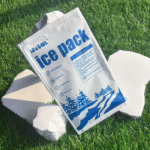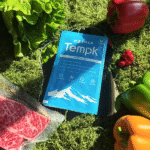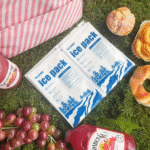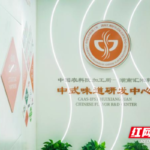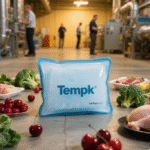How Does Cold Supply Chain Logistics Deliver Quality and Safety in 2025?
Cold supply chain logistics refers to the coordinated movement of temperature sensitive goods—such as produce, vaccines and seafood—through a network of chilled storage and transport. Di dalam 2025 this network spans farms, factories, warehouses and last mile delivery, keeping products within defined temperature ranges to prevent spoilage or contamination. Without robust cold logistics, even brief temperature deviations can ruin shipments, and cargo loss can exceed 2 trillion dollars of goods each year Given the rising demand for pharmaceuticals and fresh foods, the global cold chain logistics market is projected to grow from about masuknya US$436 miliar 2025 to US$1.359 trillion by 2034 di a 13.46 % CAGR. This guide explains how cold supply chain logistics works, which technologies and practices are critical, and what trends will define the next decade.

What does cold supply chain logistics mean and why is it critical? Explore the definition, core components and why temperature control is non negotiable.
How are different temperature categories managed? Compare ambient, Dingin, didinginkan, frozen and ultra cold supply chains.
What steps make up the cold logistics process? Follow products from harvest through pre cooling, penyimpanan, transportation and distribution.
What challenges do shippers face and how can they overcome them? Learn about temperature excursions, security risks, fragmented infrastructure and compliance.
How are IoT, AI and blockchain transforming cold logistics? Discover how sensors, predictive analytics and blockchain improve visibility and reduce waste.
Why is sustainability becoming central? Find out how renewable energy, eco friendly refrigerants and high velocity networks reduce emissions and costs.
What trends will shape cold supply chain logistics in 2025 dan seterusnya? Periksa pertumbuhan pasar, new product categories and infrastructure upgrades.
What does cold supply chain logistics mean and why is it critical?
Cold supply chain logistics—sometimes called the cold chain—is the end to end management of temperature controlled products from source to consumer. It covers pre cooling, refrigerated storage, temperature controlled transport, monitoring and documentation. Tanpanya, perishable goods can spoil quickly: menghasilkan, vaccines and biologics deteriorate when exposed to temperatures outside strict ranges. One industry study notes that even short temperature deviations can cause massive financial losses and health risks. Di Amerika Serikat saja, lebih dari US$2.7 trillion worth of temperature controlled goods were shipped by truck in 2022, representing about 90 % of all temperature controlled shipments This highlights the scale of the cold chain and the need for precision.
Why temperature control matters
Perishable products have unique persyaratan suhu. Fresh fruits and vegetables often need to stay between 2 °C dan 8 ° C., while frozen goods must remain below −18 °C. Vaccines and advanced biologics may require ultra cold conditions as low as −70 °C. When products are exposed to heat or excessive cold, microbes multiply, nutrient content declines and active ingredients can degrade. Satu temperature excursion during transport can render an entire shipment unusable. For pharmaceutical supply chains, such excursions jeopardize patient safety and regulatory compliance, leading to product recalls and liability issues. Effective cold supply chain logistics ensure that each product’s environmental needs are met at every stage.
Market importance and drivers
The cold chain is expanding due to population growth, global trade and consumer preferences. Consumers increasingly demand segar, minimally processed foods and plant based proteins that require strict temperature control. Demand for temperature sensitive pharmaceuticals and vaccines continues to soar. Itu global cold chain logistics market is forecast to expand from US$436 billion in 2025 to US$1.359 trillion by 2034, with Asia Pacific projected to grow at 14.3 % setiap tahun. Sementara itu, a surge in plant based proteins could push them to 7.7 % pasar protein global oleh 2030, valued at more than US$162 billion, further increasing the need for refrigerated transport and storage. These trends underscore the importance of robust cold logistics.
How are different temperature categories managed?
Maintaining the right temperature begins with understanding temperature categories. Each category dictates equipment, insulation and monitoring requirements:
| Temperature category | Kisaran khas | Contoh produk | Mengapa itu penting bagi Anda |
| Ambient or controlled room temperature | 15 °C–25 °C | Cokelat, canned goods | Stable goods that still need protection from extreme heat or cold |
| Dingin | 8 °C–15 °C | Anggur, certain cheeses, some pharmaceuticals | Prevents microbial growth while avoiding freezing |
| Didinginkan | 2 °C–8 °C | Produk segar, susu, vaksin | Most food and drugs fall here; tight control is vital to maintain quality |
| Beku | –18 °C or below | Es krim, daging beku | Necessary to keep products stable; frost buildup and energy usage are concerns |
| Sangat dingin | –70 °C hingga –20 °C | Vaksin mRNA, terapi gen | Requires specialized freezers, panel isolasi vakum (VIP) dan pemantauan waktu nyata |
Tip: When designing logistics for a new product, start by classifying its temperature category. This determines packaging (MISALNYA., phase change materials for vaccines), refrigeration equipment and monitoring devices. Regulatory guidelines often specify allowable ranges; plan for contingencies such as delays or power loss.
What steps make up the cold logistics process?
Cold supply chain logistics is not a single activity but a series of coordinated steps. Each step requires planning, technology and trained personnel.
Production and harvesting: The cold chain begins at the farm or factory. Products are harvested or manufactured and quickly moved to pre cooling units to remove field heat. Pre cooling ensures that produce enters storage at optimal temperatures and reduces metabolic processes.
Pre cooling and initial quality control: Products are rapidly chilled using vacuum coolers, hydro coolers or blast chillers. Quality inspections check for bruising, contamination or damage, ensuring only acceptable goods enter the chain.
Penyimpanan dingin: Goods are stored in temperature controlled warehouses. High density racking, automation and energy efficient refrigeration reduce space and cost. Many facilities integrate variable speed compressors, high R value insulation and energy management systems to optimize performance. Some warehouses also use hybrid power systems, combining grid electricity with solar panels and backup generators to ensure reliability.
Transportasi yang didinginkan: Products are loaded into truk berpendingin, railcars, marine containers or airplanes. Transporters must maintain specified temperatures, humidity and ventilation to preserve quality. Lebih dari 90 % of temperature controlled goods in the United States travel by truck, highlighting the importance of road transport Carriers often use geofencing and telematics to monitor routes, prevent unauthorized stops and mitigate theft
Monitoring and tracking: Throughout storage and transport, sensors measure temperature, kelembaban, vibration and location. Data loggers provide historical records, while IoT sensors offer real time alerts to detect deviations. Some logistics providers deploy AI enabled tracking and predictive analytics to predict failures and optimize routes
Distribution and last mile delivery: Products arrive at distribution centers or retail outlets and are transferred to smaller refrigerated units for last mile delivery. At this stage, maintaining the cold chain is challenging because shipments may be opened frequently. Training staff to minimize door openings and using insulated containers help prevent excursions. For e commerce shipments, cold couriers may use insulated boxes with phase change materials to maintain temperatures for up to 48 jam.
Documentation and compliance: At every stage, data is recorded for traceability and regulatory audits. Documentation includes temperature logs, handling procedures and chain of custody records. Regulatory frameworks such as the Undang-Undang Modernisasi Keamanan Pangan (FSMA), Praktek Distribusi yang Baik (PDB) Dan IATA’s Perishable Cargo Regulations require documented evidence that products were maintained within specification.
A closer look at monitoring tools
Different products and routes call for different monitoring technologies. Below is a comparison to help you choose the right option.
| Device type | Pro | Kontra | Terbaik untuk |
| Pencatat data | Terjangkau; robust; provide historical records for audits | No real time alerts; you discover problems only after delivery | Long haul shipments where immediate intervention isn’t critical |
| IoT wireless sensors | Send real time temperature and location data via cellular or Wi Fi; enable predictive maintenance and route optimization | Require connectivity; Biaya yang lebih tinggi; need power | Obat-obatan bernilai tinggi, makanan segar, shipments with tight temperature tolerances |
| RFID temperature tags | Contactless scanning in warehouses; multiple tags read simultaneously; reduce manual entry | Signal can be blocked by metal or liquids; requires infrastructure | High throughput distribution centers, pallet level monitoring |
| GPS trackers with temperature probes | Provide real time location and temperature; enable geofencing alerts; improve securityinboundlogistics.com | Biaya yang lebih tinggi; subscription fees; battery life limitations | Long distance transport, high value cargo, anti theft measures |
What challenges do shippers face and how can they overcome them?
Meskipun ada kemajuan teknologi, cold supply chain logistics presents numerous challenges. Understanding them helps you develop effective risk mitigation strategies.
Temperature excursions and product spoilage
Temperature deviations can occur due to equipment failure, poor insulation, loading errors or delays. Hingga 20 % of temperature sensitive products may be wasted because of inadequate monitoring or packaging. Untuk mencegah ini, map out critical control points in your facility and vehicles, calibrate equipment regularly and adopt hybrid packaging that combines refrigeration with phase change materials. Performing temperature mapping studies identifies hot spots and informs racking layout and airflow design.
Visibility gaps and delayed response
Lack of real time data slows decision making and increases the risk of losses. Integrated platforms that combine sensor data, GPS and routing information provide a single source of truth. Some logistics providers use hub based multimodal networks that integrate storage, transport and compliance to improve traceability Real time monitoring of more than 90 % of facilities allows them to take corrective action before issues become critical Unified platforms also support smart contracts and blockchain to automate payments and verify that goods remained within specification during transit.
Infrastructure constraints and aging facilities
Many cold storage facilities are decades old, lacking insulation and modern refrigeration systems. Retrofitting with high R value insulation, variable speed compressors and energy efficient lighting can reduce energy consumption by hingga 30 % and lower operating costs. Upgrading to smart reefers—refrigeration units equipped with sensors and AI driven controls—improves temperature stability and energy efficiency. When building new sites, consider modular and distributed warehousing to increase resilience during extreme weather events or geopolitical disruptions.
Security and cargo theft
High value loads of pharmaceuticals, meat or dairy are attractive targets. Carriers employ geofencing, AI and computer vision tools to validate trucks and trailers, deter theft and recover stolen goods Some carriers instruct drivers not to stop within 200–300 miles of the pickup point to discourage theft attempts Vetting carriers, equipping vehicles with telematics, ELDs and geofencing, and monitoring driver compliance reduce risks
Freight fraud and compliance risk
Freight fraud is rising, especially for high value commodities like produce, dairy and frozen goods. Logistics providers combat this by thoroughly vetting carriers and requiring telematics, ELD and geofencing technology for real time visibility and compliance Robust integration platforms stream data from telematics, machine learning and automation to provide continuous monitoring and proactive alerts, helping identify disruptions before they affect shipments
Fragmented processes and manual paperwork
Cold chain operations often involve multiple stakeholders, from farmers to customs brokers, leading to data silos and manual paperwork. Digital platforms that integrate with ERP, warehouse management systems (WMS) and transportation management systems (TMS) break down silos and automate tasks like load acceptance, penetapan harga, order entry, and exception notifications When processes are automated, staff can focus on high value activities such as customer service and strategic planning.
How are IoT, AI and blockchain transforming cold logistics?
Advanced technologies are reshaping the cold supply chain by providing visibilitas waktu nyata, predictive insights and secure data. Adoption is accelerating as companies strive to reduce waste, energy use and emissions.
Sensor IoT dan pemantauan waktu nyata
Sensor IoT mengukur suhu, kelembaban, vibration and location at high frequencies and transmit data via cellular, Wi Fi or LoRaWAN networks. Real time dashboards allow managers to monitor multiple shipments simultaneously and respond quickly to anomalies. In addition to sensors, wireless data loggers send updates at intervals, ketika smart reefer units adjust compressor speeds automatically to maintain set points and reduce energy consumption.
Predictive analytics and AI
Machine learning models analyze sensor data and historical records to memprediksi kegagalan peralatan, forecast demand and optimize routing. Studies indicate that predictive maintenance can reduce unplanned downtime by up to 50 % and lower repair costs by 10–20 %. Because refrigeration accounts for a large share of cold warehouse energy consumption, optimizing equipment operation can cut energy use by 10–30 %. AI also helps design efficient routes by incorporating traffic, weather and order data; one European operator using AI driven route optimization reduced travel time by 12 % and fuel consumption by 8 %.
Blockchain and smart contracts
Blockchain technology records temperature and chain of custody data in an immutable ledger, increasing transparency and trust. Kontrak pintar automatically trigger payments when conditions (such as maintaining specific temperatures) are met. This eliminates disputes and speeds settlement between producers, carriers and distributors. Several logistics providers have trialed blockchain platforms, linking sensors to the blockchain to guarantee data integrity and secure transactions.
Otomasi dan robotika
Warehouses are increasingly adopting sistem penyimpanan dan pengambilan otomatis (AS/RS), robotic palletizers and picking robots. These systems reduce labour costs, minimize human error and maintain temperature stability by limiting door openings. Belum, tentang 80 % of warehouses are still not automated, suggesting significant room for adoption. Robotics also support high density storage and enable 24/7 operation, critical for meeting the growing demand for rapid delivery.
Why is sustainability becoming central to cold logistics?
The cold chain is energy intensive. Refrigeration accounts for up to 70 % of a facility’s energy use, and traditional refrigerants have high global warming potential (GWP). Consumers and regulators are pushing for greener operations, and logistics providers are responding.
Energy efficiency and renewable power
Sustainability starts with reducing consumption. Variable speed compressors, pencahayaan LED, high R value insulation and heat recovery systems can reduce warehouse energy use by up to 30 %. Some providers install solar panels and hybrid electric systems, which can cut energy costs by 25 %. Refrigerated trucks are shifting to electric or hybrid powertrains, especially for last mile delivery. Solar powered refrigeration units and regenerative braking help maintain temperatures without idling engines.
Refrigerant management and eco friendly materials
High GWP refrigerants such as R 404A are being phased out. New alternatives include hydrofluoroolefins (HFO) like R 1234yf, which have GWPs below 1, and natural refrigerants like ammonia, CO₂ and propane. These options deliver performance comparable to HFCs while reducing climate impact; Namun, they require training and sometimes redesigning systems for safety. Advanced packaging materials—such as vacuum insulation panels (VIP) and phase change materials (PCMS)—maintain temperatures for long durations without active cooling. Biodegradable and recyclable insulation reduce waste.
High velocity, integrated networks
Traditional cold chains relied on static storage and long dwell times. Modern logistics is shifting to kecepatan tinggi, integrated networks, combining warehousing, transportation and compliance in a single ecosystem. Import–export hubs at ports and rail corridors reduce cross border dwell time and streamline flows By building hub based, multimodal networks, providers like Americold improve resilience and traceability These networks allow cargo to move faster while maintaining temperature integrity, reducing energy use and emissions.
Corporate social responsibility and consumer expectations
Consumers want to know the origin of their food and verify that it was handled safely Brands with transparent, sustainable supply chains gain trust and competitive advantage. Companies like Americold integrate sustainability into operations, partnerships and long term strategy to shape a more resilient cold chain In addition to investing in renewable energy and efficiency, these providers maintain in house customer service teams to ensure a human connection—highlighting that technology alone is not enough
What trends will shape cold supply chain logistics in 2025 dan seterusnya?
Lanskap rantai dingin berkembang pesat. Here are key trends that will define operations through 2025 dan seterusnya.
Market expansion and new product categories
The global cold chain logistics market is expected to grow significantly, with Asia Pacific leading the way. Itu dairy and frozen desserts segment currently holds the largest revenue share, ketika dry ice technologies account for more than 55 % of the technology share. Pre cooling facilities were valued at US$204.4 billion in 2024, Dan gudang yang didinginkan pada US$238.29 billion. Rapid growth is driven by demand for fresh produce, daging, makanan laut dan obat-obatan, but also by emerging categories: plant based proteins, probiotik, ready to eat meals and cell/gene therapies. Ultra cold storage demand is rising as more gene therapies require –70 °C logistics.
Upgraded infrastructure and regional hubs
Many facilities built decades ago must be retrofitted or replaced. Investments focus on otomatisasi, robotics and smart refrigeration systems to increase throughput and consistency Multimodal hubs at ports and rail junctions integrate storage, transportasi dan kepatuhan. Providers like Americold operate 239 facilities across 12 negara, building networks of ports, rail corridors and last mile hubs to orchestrate movement across continents Partnerships with infrastructure leaders like RSA Global, DP World and CPKC facilitate faster, more secure cross border trade
Digital twins and climate resilient design
As climate events like floods or heatwaves disrupt supply chains, companies are exploring digital twin models to simulate warehouse operations and test resilience under different scenarios. Modular warehouses and distributed storage reduce the impact of localized events; climate resilient design includes elevating facilities, waterproofing critical systems and implementing microgrids.
Collaborative logistics and shared resources
Pooling resources can reduce costs and emissions. Collaborative logistics platforms allow multiple shippers to share refrigerated assets, cross dock shipments and optimize loading. By combining loads, companies reduce partial loads and improve equipment utilization. Some networks even coordinate with competitor firms to balance flows and minimize empty backhauls.
Data standardization and interoperability
Interoperable data standards are essential for end to end visibility. Experts predict that by 2025, tentang 74 % of logistics data akan distandarisasi, enabling seamless data sharing across platforms. Standardization simplifies collaboration between manufacturers, Pemasok Pengemasan, carriers and retailers, unlocking new efficiencies and innovations. The rise of API enabled platforms makes it easier to integrate IoT data with warehouse management systems and ERP.
Regulatory tightening and traceability
Regulatory bodies are strengthening requirements for temperature control, dokumentasi dan ketertelusuran. FSMA, itu EU Falsified Medicines Directive, IATA’s Perishable Cargo Regulations Dan WHO guidelines require complete chain of custody records. Governments are also phasing out high GWP refrigerants and incentivizing energy efficiency through grants and carbon taxes. Compliance will drive the adoption of technologies like blockchain, smart packaging and advanced monitoring.
Labour and skills transformation
As automation takes over repetitive tasks, the workforce must upskill. Technicians need expertise in maintaining IoT sensors, robotics and refrigerants, while planners must analyze data and optimize operations. Training programs and partnerships with technical schools will be critical to filling this talent gap. Companies that invest in workforce development will gain a competitive advantage.
Consumer centric logistics
Direct to consumer (DTC) models for meal kits, online grocery and subscription services are accelerating. Cold chains must adapt to smaller, more frequent deliveries and stricter quality requirements. Delivery companies are experimenting with pusat pemenuhan mikro Dan refrigerated lockers to shorten last mile distances and maintain temperature control. Real time tracking apps allow consumers to monitor their orders and schedule delivery windows.
Best practices and practical tips for navigating cold supply chain logistics
Use these recommendations to strengthen your cold chain and stay competitive.
Map and control critical points
Conduct temperature mapping: Identify hot and cold spots in storage and transport equipment. Adjust airflow, insulation and loading patterns accordingly.
Calibrate equipment regularly: Test refrigeration units, sensors and thermometers at scheduled intervals to ensure accuracy.
Use hybrid packaging: Combine active refrigeration with phase change materials to maintain temperatures during unexpected delays.
Implement contingency plans: Prepare for power failures, vehicle breakdowns and customs delays. Memelihara generator cadangan, alternative transport routes and extra packaging materials.
Invest in integrated technology
Adopt real time monitoring: Deploy IoT sensors or GPS trackers with temperature probes to receive immediate alerts and location updates.
Leverage predictive analytics: Use machine learning models to predict equipment failures and route disruptions.
Automate workflows: Use software to automate tasks like order entry, penetapan harga, carrier assignment and exception notifications
Ensure data interoperability: Integrate WMS, TMS and ERP systems to break down silos and allow cross department visibility.
Strengthen partnerships and training
Vet carriers thoroughly: Require telematics, ELDs and geofencing to ensure compliance and security Check licensing, insurance and customer reviews.
Train staff in cold chain protocols: Provide regular training on hygiene, temperature management and emergency response. Emphasize the importance of minimizing door openings and proper loading techniques.
Collaborate across the chain: Work with suppliers, operator, customs brokers and retailers to align expectations, share data and plan capacity.
Berinvestasi dalam keberlanjutan: Mengadopsi energi terbarukan, low GWP refrigerants and recyclable packaging. Communicate these efforts to consumers to build trust
Studi kasus: A logistics provider serving U.S. grocers built an integrated network of solar powered cold storage facilities and electric refrigerated trucks. By implementing temperature mapping, switching to variable speed compressors and training drivers on cold chain protocols, perusahaan reduced energy costs by 25 % Dan cut spoilage by 18 %, highlighting how operational improvements and renewable energy can deliver both cost savings and sustainability.
Pertanyaan yang sering diajukan
What is the difference between cold chain logistics and normal logistics? Standard logistics focuses on moving goods efficiently without strict environmental control. Cold chain logistics requires maintaining specific temperature and humidity conditions throughout the journey to protect perishable goods and comply with regulations.
How do I choose the right refrigeration equipment? Base your choice on temperature requirements, sensitivitas produk, transit time and infrastructure. Untuk barang beku, select units capable of maintaining –18 °C or below; for ultra cold goods, invest in specialized freezers with vacuum insulation and backup systems.
Can phase change materials replace active refrigeration? Bahan perubahan fasa (PCMS) can keep products within a narrow temperature range for a limited time and are useful for last mile delivery or backup during power loss. They do not replace active refrigeration for long journeys but complement it.
What regulations govern cold supply chain logistics? Key frameworks include the FDA’s Undang-Undang Modernisasi Keamanan Pangan (FSMA), itu European Union’s Good Distribution Practice (PDB) Pedoman, itu IATA Perishable Cargo Regulations Dan WHO good storage and distribution practices. Compliance requires documented procedures, validated equipment and regular audits.
How can small businesses afford advanced cold chain technology? Start with cost effective measures: implement data loggers, upgrade insulation and train staff. Gradually adopt IoT sensors and predictive analytics as budget allows. Many third party logistics providers offer managed services that include monitoring and compliance, enabling smaller companies to benefit from advanced systems without large capital investments.
Ringkasan dan Rekomendasi
Cold supply chain logistics is critical for delivering safe, high quality food and pharmaceuticals. It involves a chain of processes—from pre cooling and storage to transportation, monitoring and last mile delivery—designed to keep products within specific temperature ranges. Key challenges include temperature excursions, visibility gaps, aging infrastructure, security risks and manual processes. Investing in pemantauan waktu nyata, analitik prediktif, blockchain Dan otomatisasi can dramatically reduce waste and improve efficiency. Sustainability initiatives—such as renewable energy, low GWP refrigerants and recyclable packaging—are becoming core to operations. Market trends indicate strong growth, new product categories and increased regulatory scrutiny.
Rencana aksi
Assess your cold chain: Identify temperature categories, high risk points and current monitoring capabilities.
Upgrade facilities: Retrofit with insulation and energy efficient refrigeration; adopt modular designs for future expansion.
Menerapkan pemantauan waktu nyata: Deploy sensors, data loggers and integrated platforms for end to end visibility.
Mengadopsi analisis prediktif: Analyze sensor data to forecast equipment failure and optimize routes.
Train and partner: Up skill staff, vet carriers and collaborate across the supply chain.
Prioritaskan keberlanjutan: Plan refrigerant transitions, invest in renewable energy and communicate progress to customers.
Tentang tempk
TempK is a leading provider of cold chain solutions. We design and supply temperature controlled packaging, sensors and refrigeration systems for food and pharmaceutical logistics. Our expertise spans pre cooling, penyimpanan dingin, angkutan Dan pemantauan, ensuring that products maintain integrity from origin to destination. We have invested in AI enabled tracking, analitik prediktif Dan sustainable refrigeration to help customers reduce waste and improve efficiency. With a global network of partners and customer service teams, we deliver scalable solutions tailored to your unique needs.
Panggilan untuk bertindak: To learn how TempK can help optimize your cold supply chain logistics, reach out today for a personalized consultation.


















